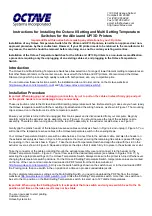
After cleaning the bearings, clean off the table and the rest of the inside of the machine.
Spending just a few minutes a week will pay off in the long run with better quality and
performance.
OPTICS:
About once a week, you will need to clean the optics (mirrors and lenses) of
your Radius. If smoke, resin, or other contaminants are allowed to accumulate too heavily,
they will reduce the available laser power and may even cause damage.
The two optical components most likely to require cleaning are the focus lens and the
mirror directly above it. The lens can be removed from the mount to make cleaning easier. The
lens is mounted in a colored (red, blue or green) retainer. Please don’t disassemble the
retainer, as the lens itself is fragile. In addition, there is one other mirror at the right end of the
“I” beam that will need cleaning.
To clean the optics use a high-quality cotton swab moistened with reagent-grade
acetone, ethyl alcohol, or anhydrous isopropyl alcohol. Acetone is supplied in your accessories
kit. Please read the label on the bottle carefully. Do not use rubbing alcohol or "hardware
store" solvents such as denatured alcohol, as they contain impurities which can contaminate the
optics. If chemicals are not readily available in your area, you may obtain pure ethyl (grain)
alcohol at any liquor store, under such brand names as "Golden Grain" and "Everclear."
Wet the swab thoroughly with the solvent, and then blot it against a paper towel or
piece of cotton so that it is no longer soaking-wet. Then daub the optic gently, rotating the
swab after each daub to expose clean cotton to the surface, until the optic is free of visible
contamination. At that point, prepare a fresh swab and clean the surface with a gentle zigzag
motion across it. Avoid any hard "scrubbing" of the surface, especially while there are visible
particles on it, and try not to use repetitive circular motions. When you are done, be careful to
remove any cotton threads that may have snagged on the mountings, and allow the optics to dry
before you operate your engraver.
LASER: The laser tube used in the Epilog engraver does have a maximum service life. The
amount of engraving time that you get from a tube will depend to a large extent on how much
material you remove from your plaques. Typical tube life is 10000 - 20000 hours, operating.
Depending on your particular usage, the tube should be good for a very long time. The tubes
are refurbished and are available on an exchange basis.
49






































